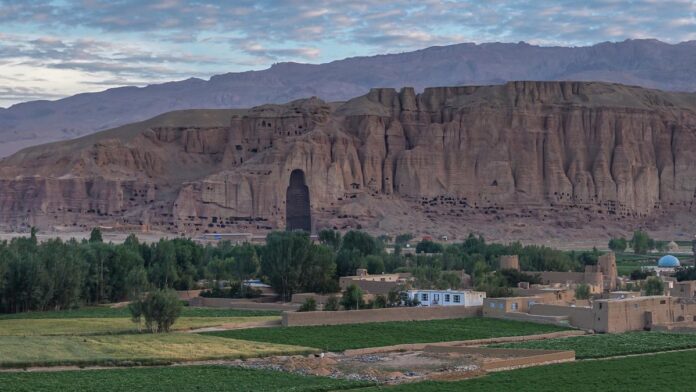
The Taliban had destroyed the Bamiyan Buddha statues.
| Photo Credit: Getty Images/iStockphoto
We were exchanging notes on our time in Afghanistan, a new elderly acquaintance of mine and the far more elderly me. He had been in Kabul for several years in the first decade of this century. I was there almost 50 years ago — 1958 to 1961. He mentioned visiting the Buddhas of Bamiyan, since destroyed by the Taliban. Remembering my visit to Bamiyan, I asked, “Did you enjoy the drive?” He said he had flown from Kabul. In my time in Afghanistan, Bamiyan, over a hundred miles from Kabul, was only accessible by narrow dusty roads. A friend of mine had taken me there in his Land Rover jeep. We had started early one summer morning and got to Bamiyan by evening.
Tiring though it was, the trip has stayed in my mind as much as, if not more than, the Buddhas themselves. At least some of the black-and-white pictures I had shot of the sights on the way bear testimony to that: camel caravans, striking Afghan faces, loaded donkeys being driven by a man, an old shrunken woman on the back of a camel being led by a boy of 10 or 12 .… The images are still vivid.
At a bend of the road, we had seen a camel caravan approaching, and my friend had pulled up to a side to let it pass. He called it a camelcade a la cavalcade! The camel, with head held high, nose in the air, disdainful of its surroundings and chewing away nonstop with a wide sweep of its jaws, is the embodiment of meditative detachment!
We had heard of ‘Kuchis’, a nomadic tribe that knew no borders, and wondered if the caravan, with goats and sheep in tow, was theirs.
We stopped under a wayside tree for a beer and sandwich lunch. Not a soul could be seen in the sheer wilderness all around, only brown barren hills on either side with little or no vegetation. It was eerie, to say the least. As we got back into the jeep, three boys of age between 10 and 12 materialised from nowhere and rushed to pick up the discarded beer cans. We knew they would be refashioned into tea mugs with tin handles fixed on them.
It was still daylight when we checked into our hotel, rather the semblance of one, on a hill, half a kilometre from the rock-cliff. From its front yard, you had a panoramic view of the cliff. Even with its wide angle lens, my camera could not get a full picture of the cliff, with its several standing Buddhas.
After an overnight stop at the hotel we drove on another 40 miles or so on a treacherous dust road to Band-i-Amir to see its complex of blue lakes, at an altitude of over 10,000 feet in what was called Hazarajat. The interconnected lakes were a memorable sight, indeed. We did not see any human habitation on our way there. At one of the lakes we heard a voice, and spotted a man, an Afghan, at the door of a small hut on the shore. He was speaking on the phone! It was only then that we noticed the phone lines and poles.
From what I heard from my acquaintance, you can now have conducted tours of places of tourist interest in Afghanistan. You can fly from Kabul to Bamiyan in less than an hour. To me, half the fun, or maybe all the fun, was on the way to Bamiyan and back by road, not the sight of the ruins of the marvellous Buddhas but snapshots of the living life en route. How can I ever forget the sight of the shriveled old woman on the back of a camel led by a boy of 10 or 12?
#Afghanistan #diaries #Hindu
